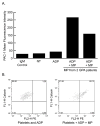The interface of inflammation and subclinical atherosclerosis in granulomatosis with polyangiitis (Wegener's): a preliminary study
- PMID: 26024800
- PMCID: PMC4862201
- DOI: 10.1016/j.trsl.2015.04.001
The interface of inflammation and subclinical atherosclerosis in granulomatosis with polyangiitis (Wegener's): a preliminary study
Abstract
The objective of this study is to assess the relationship between inflammatory disease in granulomatosis with polyangiitis (GPA, Wegener's) and the development of subclinical atherosclerosis. A total of 46 adult patients with GPA were enrolled. Disease status was measured by Birmingham vasculitis assessment scores as modified for GPA, vasculitis damage index, disease duration, and number of relapses. Classic atherosclerotic risk factors, platelet aggregation responses, and circulating microparticle (MP) levels were recorded. All patients underwent carotid artery intima-media thickness (IMT) measurement as outcome for subclinical atherosclerosis. In univariate analyses, systolic and diastolic blood pressure, creatinine, and age were significantly associated with higher IMT (ρ values 0.37, 0.38, 0.35, and 0.054, respectively [P < 0.02 for all]). In a multiple regression model, greater number of relapses, older age at the onset of disease, and higher diastolic blood pressure were found to be associated with higher IMT (P values 0.003, <0.001, and 0.031, respectively). MP counts and platelet reactivity correlated well with disease activity in GPA. Furthermore, MPs were found to activate vascular endothelial cells and platelets in vitro. The cumulative burden of systemic inflammation in GPA correlated with the development of subclinical atherosclerosis. The correlation with subclinical atherosclerosis could be because of glucocorticoid use and not the inflammatory process in GPA, giving the inherent bias that exits with the use of glucocorticoid with each relapse. The findings of increased levels of circulating leukocyte-derived MPs and enhanced platelet reactivity during relapse suggest possible roles for MPs and platelets in disease pathogenesis and support a growing literature that links inflammation, atherosclerosis, and platelet activation. This hypothesis is further substantiated by our demonstration that MPs isolated from plasma of GPA patients can activate platelets and vascular endothelial cells.
Copyright © 2015 Elsevier Inc. All rights reserved.
Conflict of interest statement
Figures



Similar articles
-
Enhanced endothelium-dependent microvascular responses in patients with Wegener's granulomatosis.J Rheumatol. 2007 Sep;34(9):1875-81. Epub 2007 Jul 15. J Rheumatol. 2007. PMID: 17659753
-
Endothelial dysfunction in patients with granulomatosis with polyangiitis: a case-control study.Rheumatol Int. 2018 Aug;38(8):1521-1530. doi: 10.1007/s00296-018-4061-x. Epub 2018 May 30. Rheumatol Int. 2018. PMID: 29850964 Free PMC article.
-
Enhanced platelet-derived microparticle formation is associated with carotid atherosclerosis in convalescent stroke patients.Platelets. 2013;24(1):63-70. doi: 10.3109/09537104.2011.654292. Epub 2012 Feb 28. Platelets. 2013. PMID: 22372532
-
Uncommon presentations of primary systemic necrotizing vasculitides: the Great Masquerades.Int J Rheum Dis. 2014 Jun;17(5):562-72. doi: 10.1111/1756-185X.12223. Epub 2013 Nov 14. Int J Rheum Dis. 2014. PMID: 24237487 Review.
-
Valvular involvement in granulomatosis with polyangiitis: Case report and systematic review of literature.Echocardiography. 2018 Sep;35(9):1456-1463. doi: 10.1111/echo.14094. Epub 2018 Jul 8. Echocardiography. 2018. PMID: 29982993
Cited by
-
Cardiac involvement and cardiovascular risk factors in pediatric primary systemic vasculitides.Clin Rheumatol. 2023 Mar;42(3):673-686. doi: 10.1007/s10067-022-06434-2. Epub 2022 Nov 12. Clin Rheumatol. 2023. PMID: 36369404 Review.
-
The microvesicle/CD36 complex triggers a prothrombotic phenotype in patients with non-valvular atrial fibrillation.J Cell Mol Med. 2020 Jul;24(13):7331-7340. doi: 10.1111/jcmm.15311. Epub 2020 Jun 8. J Cell Mol Med. 2020. PMID: 32510852 Free PMC article.
-
Arterial Stiffness as a Surrogate Marker of Cardiovascular Disease and Atherosclerosis in Patients with Vasculitides: A Literature Review.Diagnostics (Basel). 2023 Dec 5;13(24):3603. doi: 10.3390/diagnostics13243603. Diagnostics (Basel). 2023. PMID: 38132187 Free PMC article. Review.
-
Recent advances in Extracellular Vesicles and their involvements in vasculitis.Free Radic Biol Med. 2021 Aug 1;171:203-218. doi: 10.1016/j.freeradbiomed.2021.04.033. Epub 2021 May 2. Free Radic Biol Med. 2021. PMID: 33951487 Free PMC article. Review.
-
Extracellular vesicles in autoimmune vasculitis - Little dirts light the fire in blood vessels.Autoimmun Rev. 2019 Jun;18(6):593-606. doi: 10.1016/j.autrev.2018.12.007. Epub 2019 Apr 5. Autoimmun Rev. 2019. PMID: 30959208 Free PMC article. Review.
References
-
- Hoffman GS, Kerr GS, Leavitt RY, et al. Wegener granulomatosis: an analysis of 158 patients. Annals of internal medicine. 1992 Mar 15;116(6):488–98. - PubMed
-
- ZAENKER M. Accelerated atherosclerosis in Wegener’s granulomatosis: a sonographic case-control study on intima media thickness. Arthritis Rheum. 2002:S185.
Publication types
MeSH terms
Substances
Grants and funding
LinkOut - more resources
Full Text Sources
Other Literature Sources
Medical

